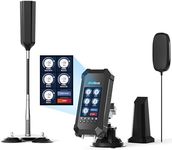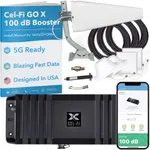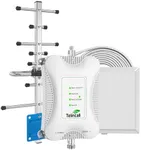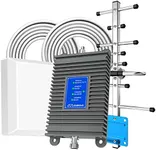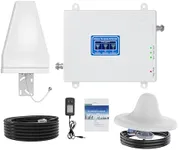Buying Guide for the Best T Mobile Cell Phone Signal Boosters
Choosing the right T-Mobile cell phone signal booster can significantly improve your mobile experience by enhancing signal strength and coverage. Signal boosters are designed to amplify weak signals, making it easier to make calls, send texts, and use data services. When selecting a signal booster, it's important to consider several key specifications to ensure you get the best fit for your needs.Coverage AreaCoverage area refers to the size of the space that the signal booster can effectively cover. This is important because it determines how much of your home, office, or vehicle will receive improved signal strength. Coverage areas are typically measured in square feet. Small boosters may cover areas up to 1,500 square feet, suitable for single rooms or small apartments. Medium boosters can cover areas between 1,500 to 5,000 square feet, ideal for larger homes or offices. Large boosters can cover areas over 5,000 square feet, perfect for expansive properties or commercial spaces. To pick the right one, consider the size of the area where you need better signal coverage.
Frequency BandsFrequency bands are the specific ranges of radio frequencies that the signal booster can amplify. T-Mobile uses several frequency bands for its network, including bands 2, 4, 12, 66, and 71. It's important to choose a booster that supports the frequency bands used by T-Mobile in your area to ensure compatibility and optimal performance. If you're unsure which bands are used, you can check T-Mobile's coverage maps or contact their customer service. Selecting a booster that supports multiple bands can provide better overall coverage and performance.
GainGain is a measure of how much the signal booster can amplify the incoming signal, typically expressed in decibels (dB). Higher gain means stronger signal amplification. Signal boosters usually offer gain levels ranging from 50 dB to 70 dB. For urban areas with relatively good signal, a lower gain booster (50-60 dB) may be sufficient. In rural or remote areas with very weak signals, a higher gain booster (60-70 dB) is recommended. To pick the right gain, consider the current signal strength in your area and how much improvement you need.
Antenna TypeSignal boosters come with different types of antennas, including omnidirectional and directional antennas. Omnidirectional antennas can receive signals from all directions and are easier to install, making them suitable for areas with moderate signal strength. Directional antennas focus on signals from a specific direction, providing stronger amplification but requiring more precise installation. If you live in an area with weak signal from a specific direction, a directional antenna may be more effective. For general use, an omnidirectional antenna is usually sufficient.
InstallationInstallation refers to the process of setting up the signal booster, including placing antennas and connecting cables. Some boosters are designed for easy DIY installation, while others may require professional help. Consider your comfort level with installation tasks and whether you prefer a plug-and-play solution or are willing to invest time in a more complex setup. Easy installation boosters are ideal for users who want quick and hassle-free setup, while more complex systems may offer better performance but require more effort.


